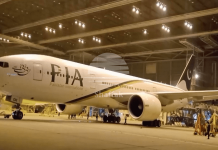ISLAMABAD, April 22 (INP): The second phase of the China-Pakistan Economic Corridor (CPEC) is moving ahead in the right direction with a focus on industrialization, agricultural modernization, information technology, and scientific and technological cooperation, WealthPK reported.
The goal of CPEC Ph-II is to enjoy the benefits of the investment in the first phase, which has established an enabling environment for investment in other industries by filling existing infrastructural and energy gaps, reports WealthPK.
Many of the CPEC projects have already been completed, while some are in construction, planning, and implementation phases. A total of 20 projects worth $14.2 billion have been completed, including nine energy projects, five projects of transport and infrastructure, two projects for Gwadar Port and Free Zone, and four projects of socio-economic development. As many as 33 projects worth $12 billion are under construction, including eight energy projects, five projects of transport and infrastructure, three projects of Gwadar Port and Free Zone, 13 projects of socio-economic development, and four projects of special economic zone (SEZ) development.
Moreover, 40 projects worth $28 billion are in the pipeline, including five energy projects, 17 projects of transport and infrastructure, 13 projects of socio-economic development, and five projects of SEZ development.
Several new projects were launched last year, including Hoshab Awaran Section, Pak-China Friendship Hospital, and Technical Vocational Institute Gwadar. Afghan transit trade was started at full capacity from Gwadar Port in April last year, and the Gwadar Free Zone was given a long-term tax exemption.
In addition to the agreed projects between the two countries, cooperation has also been extended to other avenues such as agriculture, science and technology, and tourism. The first joint working groups (JWGs) on agriculture, information technology, and scientific and technological cooperation were established, and the first meeting was held last year.
A national action plan for agricultural mechanization was prepared, and the government formed the National Locust Control Centre (NLCC) to control locusts. There are 32 proposals for the science and technology sectors that are in various stages of consultation with China. Moreover, development of SEZs is on the priority list, and the Rashakai zone’s development agreement has already been signed with Chinese developers.
The CPEC Authority is working closely with Board of Investment (BOI) and other ministries to enable “plug and play” facilities in the SEZs. The CPEC Authority is also setting up an Investors Facilitation Centre for the investors in CPEC SEZs. The centre will work closely with all the government departments to make the investment process smooth and hassle-free.
Potential areas of cooperation in agriculture include agricultural mechanization, development of an agri-value chain, as well as corporate farming and capacity building through research. The Ministry of National Food Security and Research is already working with its counterpart¬ in Beijing to develop project proposals in these areas.
Similarly, the Ministry of Science and Technology has also identified specific projects for collaboration with the Chinese side, which will be shared during the next meeting of the JWG. An MoU for a new JWG for Information Technology was signed during the 10th Joint Cooperation Committee (JCC) meeting. Potential areas for cooperation under the new JWG include: optic fiber network expansion, special technology zones, mobile manufacturing facilities, internet of things, digital payment systems, cloud computing, cyber security, services support centre, and skills development centre.





